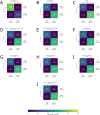Single-lead arrhythmia detection through machine learning: cross-sectional evaluation of a novel algorithm using real-world data
- PMID: 37734747
- PMCID: PMC10514635
- DOI: 10.1136/openhrt-2022-002228
Single-lead arrhythmia detection through machine learning: cross-sectional evaluation of a novel algorithm using real-world data
Abstract
Background: Computer-assisted interpretation of single-lead ECG is the preliminary method for clinicians to flag and further evaluate an arrhythmia of clinical importance for acutely ill patients. Critical scrutiny of novel detection algorithms is lacking, particularly in external real-world data sets. This study's objective was to evaluate a hybrid machine learning model's ability to classify eight arrhythmias from a single-lead ECG signal from acutely ill patients.
Methods: This cross-sectional external retrospective evaluation of a previously trained hybrid machine learning model against an ECG reading team in the setting of home hospital care (acute care delivered at home substituting for traditional hospital care) draws from patients admitted at two hospitals in Boston, Massachusetts, USA between 12 June 2017 and 23 November 2019. We calculated classifier statistics for each arrhythmia, all arrhythmias and strips where the model identified normal sinus rhythm.
Results: The model analysed 2 680 162 min of single-lead ECG data from 423 patients and identified 691 478 arrhythmias. Patients had a mean age of 70 years (SD, 18), 60% were female and 45% were white. For any arrhythmia, the model had a sensitivity of 98%, a specificity of 100%, an accuracy of 98%, a positive predictive value of 100%, a negative predictive value of 93% and an F1 Score of 99%. Performance was best for pause (F1 Score, 99%) and worst for paroxysmal supraventricular tachycardia (F1 Score, 92%). The model's false positive rate for any arrhythmia was 0.2%, ranging from 0.4% for pause to 7.2% for paroxysmal supraventricular tachycardia. The false negative rate for any arrhythmia was 1.9%.
Conclusions: A hybrid machine learning model was effective at classifying common cardiac arrhythmias from a single-lead ECG in real-world data.
Keywords: ARRHYTHMIAS; Arrhythmias, Cardiac; Electrocardiography.
© Author(s) (or their employer(s)) 2023. Re-use permitted under CC BY-NC. No commercial re-use. See rights and permissions. Published by BMJ.
Conflict of interest statement
Competing interests: DML and SRL receive grant support from Biofourmis and IBM.
Figures



Similar articles
-
Performance of a Convolutional Neural Network and Explainability Technique for 12-Lead Electrocardiogram Interpretation.JAMA Cardiol. 2021 Nov 1;6(11):1285-1295. doi: 10.1001/jamacardio.2021.2746. JAMA Cardiol. 2021. PMID: 34347007 Free PMC article.
-
The quality of ECG data acquisition, and diagnostic performance of a novel adhesive patch for ambulatory cardiac rhythm monitoring in arrhythmia detection.J Electrocardiol. 2019 May-Jun;54:28-35. doi: 10.1016/j.jelectrocard.2019.02.012. Epub 2019 Feb 28. J Electrocardiol. 2019. PMID: 30851474
-
Automated detection of shockable and non-shockable arrhythmia using novel wavelet-based ECG features.Comput Biol Med. 2019 Dec;115:103446. doi: 10.1016/j.compbiomed.2019.103446. Epub 2019 Sep 18. Comput Biol Med. 2019. PMID: 31627019
-
ECG-based heart arrhythmia classification using feature engineering and a hybrid stacked machine learning.BMC Cardiovasc Disord. 2025 Apr 7;25(1):260. doi: 10.1186/s12872-025-04678-9. BMC Cardiovasc Disord. 2025. PMID: 40189503 Free PMC article.
-
Cardiac arrhythmia detection using deep learning: A review.J Electrocardiol. 2019 Nov-Dec;57S:S70-S74. doi: 10.1016/j.jelectrocard.2019.08.004. Epub 2019 Aug 8. J Electrocardiol. 2019. PMID: 31416598 Review.
Cited by
-
Low-cost and convenient screening of disease using analysis of physical measurements and recordings.PLOS Digit Health. 2024 Sep 19;3(9):e0000574. doi: 10.1371/journal.pdig.0000574. eCollection 2024 Sep. PLOS Digit Health. 2024. PMID: 39298384 Free PMC article. Review.
References
-
- Kalra A, Lowe A, Al-Jumaily A. Critical review of electrocardiography measurement systems and technology. Meas Sci Technol 2019;30:012001. 10.1088/1361-6501/aaf2b7 - DOI
Publication types
MeSH terms
LinkOut - more resources
Full Text Sources
Medical
